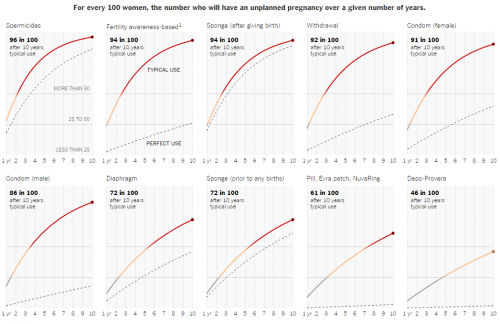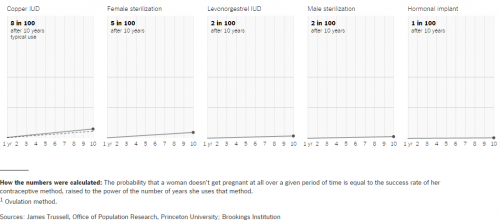This week the New York Times published an interactive that illustrates the likelihood of pregnancy despite contraceptive use. Risk is divvied up by method, for perfect and typical use, and added up over ten years. The results are a little terrifying (click to see larger or go here to explore):
Somewhere around half of all pregnancies are unintended. This is why. It’s hard enough to use contraceptives perfectly but, even when we do, the risk of failure is very real.
Male condoms are the safer sex favorite. But, even when used perfectly, almost one in five women will get pregnant over a ten year period. With typical use, more than four out of five. Withdrawal, one primary foil against which male condoms are usually recommended, is only slightly less effective at preventing pregnancy, as typically used.
The favorite of Americans — The Pill, as well as some other hormonal methods — is more effective than the condom, but not nearly as much as we think it is. Under ideal conditions, only three in 100 will get pregnant over ten years; in reality, almost two-thirds — 61 in 100 — will end up pregnant.
Only the most human-error resistant methods — the IUD, hormonal implants, and sterilization — near 100% effectiveness. These are permanent or semi-permanent and not real options for a large proportion of sexually active Americans during at least some parts of their lives.
Discussions of the right to an abortion and the ease with which they can be attained needs to be had with this information at the forefront of the discussion. Unintended pregnancies happen all the time to everyone.
Cross-posted at Pacific Standard.
Lisa Wade, PhD is an Associate Professor at Tulane University. She is the author of American Hookup, a book about college sexual culture; a textbook about gender; and a forthcoming introductory text: Terrible Magnificent Sociology. You can follow her on Twitter and Instagram.


Comments 19
Laura Mariani — January 24, 2015
This article contains a lot of inaccuracies, beginning with "This week..." (this infographic is from September). But even more importantly, the statistical methods used to generate these graphs are VERY misleading -- in brief, they're oversampling people for whom contraceptives fail by assuming that failure rates occur equally across the entire population. This is explained in more detail here: http://www.theamericanconservative.com/.../the-new-york.../
I wouldn't have thought I'd agree with analysis from a site called "The American Conservative," but the math is good.
MMK — January 24, 2015
As someone who has had an IUD since age 20, through various life stages, I can't recommend it enough. I've had both the Paragard and Mirena types. If you are not in a monogomous relationship, add a condom. But I cannot tell you how often I have come across (always male) GYNs who have tried to remove it without my consent during exams. Thank goodness for progressive female GYNs who empowered me to make my own contraceptive choices.
Chart of the Week: We Have Less Control Over Our Reproductive Bodies Than We Think - Treat Them Better — January 24, 2015
[…] Chart of the Week: We Have Less Control Over Our Reproductive Bodies Than We Think […]
caryatis — January 24, 2015
This is an incredibly deceptive article. 95% of unintended pregnancies happen to women who don't use contraception, either not consistently or not at all. Women who use highly effective contraception are very unlikely to ever have to deal with this problem. And I see no justification for saying that IUDs and implants "are not real options." They are real options, and they work well, and every woman who doesn't want to get pregnant should be using them.
For the record, I support legal abortion too, but Lisa Wade should know better than to twist the facts in support of that conclusion.
http://www.guttmacher.org/pubs/FB-Unintended-Pregnancy-US.html
ellie — January 25, 2015
"Somewhere around half of all pregnancies are unintended. This is why."
This statement is highly misleading. Unintended pregnancy rates vary by country - many regions (such as Western Europe) have far lower percentages of unintended pregnancies. Contraceptive failure rates (even with erect use) do account for a significant component of unintended pregnancies, but other factors contribute to the rest. To name just a few, these include education about and cultural attitudes toward sex and pregnancy, varied contraceptive availability and affordability, histories of contraceptive coercion or abuse, and the medical training of health care providers.
To be clear, I support abortion on demand no matter what, and do think it is important for people to understand that even under "ideal" contraceptive conditions there will continue to be unintended pregnancies. I just think it's misleading to present this without the proper context that acknowledges unintended pregnancy is also culturally and geographically specific!
pencilears — January 27, 2015
I <3 my hormonal implant.
Voorbehoedsmiddelen falen vaker dan je denkt | De Zesde Clan — February 2, 2015
[…] Natuurlijk kun je het risico verminderen door diverse middelen tegelijkertijd te gebruiken. Hij doet braaf iedere keer een condoom om terwijl zij braaf de pil slikt. Nog steeds zullen voorbehoedsmiddelen echter falen. Zeer veel vrouwen en mannen krijgen zodoende te maken met ongeplande zwangerschappen. En dat deden ze niet alleen: daar was een man bij betrokken. Geen enkel debat kan om deze twee harde feit heen. […]
anon — February 2, 2015
Many years ago, when I had a tubal ligation, I read a pamphlet with numbers similar to the chart above for sterilization. I was shocked!
In the consultation with my doctor I said something like, "What? 5 in 100? No way! I want lottery odds, at least 1 in 10,000. Should I continue using other birth control after the sterilization? Or can you cut each tube twice or something?"
And I was only half kidding.
Luckily it worked out fine for me, no pregnancies.
Decidir. | Qué Joder — February 11, 2015
[…] eliminando el abuso sexual como causa, tenemos menos control sobre la reproducción de lo que creemos: “alrededor de la mitad de los embarazos ocurren sin intención. Este es el por qué. Ya es […]